Stay in the know on all smart updates of your favorite topics.
27 Charging Hubs Challenge
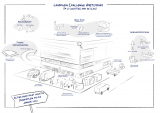
How can 27 government-owned buildings in Amsterdam create charging hubs despite grid congestion? Since the beginning of this year, these buildings have been under the management and maintenance of SPIE. Recognising the potential challenges posed by grid congestion, SPIE has brought forward this issue to explore viable solutions. While immediate capacity may not always be available, innovative approaches — such as smart charging strategies, optimized energy management within the buildings, or, in critical cases, the use of generators — can make implementation possible. To achieve this, collaboration is key. With this challenge, we aim to form a consortium of partners who can work together to develop scalable solutions for any scenario.
The Circular Utility Hub Challenge

The City of Amsterdam has taken the initiative to develop the Modular Circular Utility Hub, an innovative concept aimed at providing a future-proof solution to challenges related to space utilization, finances, technology, aesthetics, and climate. The Nutshub concept is part of two parallel trajectories: a local innovation process that was already underway and a second trajectory in which the concept is being submitted as part of the EU call "Rethinking Urban Spaces Towards Climate Neutrality."
Project Phase
The project is currently in its research- and implementing phase. A significant step was taken during a digital meeting on December 19, 2024, where a coalition of stakeholders began forming, and the plans for the EU subsidy application were further solidified.
What is the goal of the project?
The primary goal of the project is to demonstrate the Utility Hub concept on a practical level through two pilot projects. These pilots will showcase how utilities and shared elements, such as solar panels and community functions, can be integrated into public spaces. This approach aims to optimize space usage, offer more sustainable solutions, and improve the quality of life in increasingly dense urban areas.
What are the expected results?
The initial outcome of the project includes enthusiastic commitments from various project partners to support the EU subsidy application. These commitments provide a strong foundation for the further development and implementation of the Utility Hub pilots. Additionally, a collective approach and shared sense of urgency surrounding the challenges have been reaffirmed.
Two pilot projects are set to develop the Utility Hub concept, enhancing the quality of public spaces. Several organizations have committed as project partners, while others will act as executing parties without formal roles.
Plans for 2025
In 2025, the focus will shift to refining the subsidy application and further developing the pilot projects. Key steps include:
- Finalizing work packages and project structure in January.
- Continuing collaboration with knowledge institutions.
- Organizing follow-up meetings.
- Building a coalition with other interested parties.
Who initiated the project, and which organizations are involved?
The project was initiated by the City of Amsterdam. The following organizations are involved:
Project partners: Amsterdam University of Applied Sciences (HvA), AMS Institute, TNO, and VDL.
Executing parties: Alliander, Vattenfall, and Bright.
Internationally, Lyon and Stockholm are involved as the Lead City and Lighthouse Cities, respectively.
What’s next?
The coalition of project partners, together with the City of Amsterdam, will submit an application for the EU Horizon Call. The deadline for submission is February 11, with the hope of securing the funding to bring the vision to life. It is important to note that even if the EU does not approve the project, the local innovation trajectory will continue independently.
Zero Emission Urban Logistics Challenge
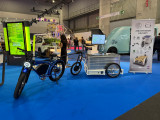
From January 1 2025, a zero-emission zone will be introduced in the centre of Amsterdam, with the aim of improving air quality and making the city healthier and more liveable. This policy helps achieve climate goals and supports the ambition of becoming climate neutral by 2050. It encourages zero-emission urban logistics, which contributes to reduced pollution, noise, and traffic congestion. And cleaner air also has positive effects on the health and well-being of residents. With this initiative, Amsterdam - and other Dutch cities implementing such zones this year - aim to set an example for other cities and stimulate innovation in sustainable mobility. The so-called "zero-emission zone" is therefore an essential measure in the transition to a cleaner and more sustainable city.
This transition will only succeed through collaboration. Therefore, considerable attention is being paid to the experiences and needs of small business owners in the city. Think of; market vendors, house painters, and local greengrocers. What kind of support do they need to transition to zero-emission vehicles, and how do entrepreneurs creatively adapt to the transition and new rules? Other cities and municipalities are closely observing and there is a strong need for knowledge sharing. It is important that the experiences and lessons learned from Amsterdam, as one of the pioneers, are well-documented and shared on a national and international scale.
Mobility Justice Challenge: How do we prevent people’s exclusion in our mobility system?

Rising petrol and electricity prices; increasing digitalisation and declining public transport supply, among other things, are causing more and more people to have problems getting around. Sustainability and shared mobility do not seem to be for everyone, and measures to encourage them may even exacerbate the problem. This increases the risk of social exclusion.
Since mid 2022, we have been working on the topics of inclusion, mobility poverty and mobility justice with our network partners in various working group sessions. Would you like to know more about our efforts, or the progress of the current working group? Contact me at pelle@amsterdamsmartcity.com.
Energiemanagement in huis
Hoi Allen,
Met het team van Smart Butler werken we aan een project waarbij we de energie transitie kunnen versnellen.
Energiemanagement is the key daarin.
Met ons eigen dashboard kunnen we praktisch elk apparaat met elkaar laten communisten. In plaats van slimme apparaten ontstaat er een slim huis waarin apparaten samenwerking om het Energiemanagement af te stemmen.
https://www.smartbutler.nl/haal-alles-uit-je-zonnepanelen-met-energiemanagement/
We zijn altijd op zoek naar mensen die ons in deze uitdagende missie kunnen helpen. Neem een kijkje op onze website. De koffie staat altijd klaar.
De Stadspergola

De Stadspergola nodigt uit tot een brede samenwerking tussen onderwijs, onderzoek en praktijk. We verkennen welke functies en vakgebieden er allemaal aan het stadsmeubilair van de toekomst verbonden kan worden.
Schaduwbehoefte
Door het veranderende klimaat en toename van extreme hittegolven komt er steeds vaker hittestress voor. Bomen zijn een effectief middel om schaduw te bieden en de gevoelstemperatuur te verminderen. Echter kunnen bomen lang niet overal (in goede) omstandigheden groeien vanwege de vele belangen en functies die samenkomen in het stedelijk gebied, zowel boven- als ondergronds. Daarnaast is tijd een beperkende factor; het kost jaren voordat bomen volgroeid zijn en hun verschillende functies kunnen vervullen als het gaat om schaduw, biodiversiteit en uitstraling. Alternatieve interventies voor het creëren van schaduw en vergroening, zoals bijvoorbeeld een pergola, kunnen helpen om steden (versneld) klimaatbestendiger in te richten.
Open blik en brede benadering
Maar kan een Stadspergola ook verder gaan dan schaduwwerking en de stad klimaatbestendiger maken? Deze vraag stond aan de wieg van dit prototype van de Stadspergola, gerealiseerd op de HvA Amstelcampus, in de zomer van 2023. Er volgde een feestelijke lancering in september waar docenten, beleidsmakers, onderzoekers, studenten en burgers met elkaar het gesprek aan gingen over allerlei verschillende functies die de Stadspergola kan bekleden. Tijdens de workshop borrelden veel vragen en mogelijkheden op, in te delen in de categorieën: wat ervaar je graag? Welke functies zie je? Welke kansen en valkuilen kunnen we identificeren en wat zijn mogelijke vervolgstappen? Het merendeel van de antwoorden door de aanwezigen is in kaart gebracht door illustrator Mei-Li. Hieruit zijn ook weer onderzoeksvragen ontstaan, waar verschillende vakgebieden worden aangesproken:
- Hoe bouwen we circulaire stadspergola's?
- Op welke manier kan een stadspergola bijdragen aan de biodiversiteit?
- Wat voor sociale functie in de buurt kan de stadspergola dienen?
Interactief en in ontwikkeling
Uit de grote hoeveelheid aan reacties valt op te maken dat vele thema's en vakgebieden verbonden kunnen worden aan de stadspergola. Dit prototype is een dynamisch object dat zich blijft ontwikkelen en iedereen is welkom om mee te bouwen zodat we toewerken naar duurzaam straatmeubilair wat kan voorzien in de veelzijdige behoeften van de stad. Dit willen dit dan ook graag samen verkennen met iedereen die zich betrokken voelt.
Kennisdeling via toolkit
Met als doel zoveel mogelijk opgedane kennis, zo snel mogelijk, te delen met geïnteresseerden, is er een communicatie toolkit samengesteld met de volgende informatie. Deze is in zijn geheel, of gedeeltelijk, te downloaden via de linkjes hieronder.
- Paspoort met beschrijving van hoe de pergola is gebouwd, zoals de afmetingen, het materiaal en de beplanting.
- Inspiratiekaarten met voorbeelden van Stadspergola’s internationaal en nationaal. Dit zijn voorbeelden van stadspergola’s die wij hebben ontvangen van collega’s, vrienden, familie en andere betrokkenen. Er zijn vast nog meer voorbeelden te vinden, maar het roept de vraag op wat nu precies een stadspergola is:
- is het begroeid met planten of niet, (en als het bedoeld was te begroeien, waarom groeit het dan niet?)
- is het onderdeel van een gebouw of staat het los
- is het ontwerp een ‘standaard; of een ‘special?’
- esthetisch of functioneel (en voor welke functies dan?)
- op welke plek zinnig/nuttig (een pergola in de schaduw of juist in de volle zon)
- Pleidooi voor het verkennen van de mogelijkheden van de stadspergola: van idee op papier naar plek op het plein
- De lessons learned tot nu toe. Welke inzichten hebben we al gekregen, naast degene beschreven in het pleidooi, om mee te nemen voor het bouwen van een tweede prototype stadspergola
- De uitkomsten van de workshop tijdens de lancering van de stadspergola waar de opgehaalde gewenste ervaringen, functies, kansen, valkuilen en vervolgstappen zijn verwerkt in een tekening.
- Verslag bijeenkomst met experts op het gebied van ecologie, landschapsontwerp en natuurinclusiefontwerp over het 'levende' gedeelte van de Stadspergola.
- Artikel over de Stadspergola in Stadswerk magazine, het vakblad voor professionals werkzaam op het gebied van de fysieke leefomgeving.
Er zal in de loop van de tijd steeds meer informatie beschikbaar komen. Denk aan ontwerpen gemaakt door studenten, overzicht van onderzoeksvragen en hopelijk realisaties van meer (prototypes) van stadspergola’s.
Samenwerken
Wil je graag meewerken? Of heb je vragen over dit project? Stuur een mailtje naar: l.a.corpel@hva.nl (docent-onderzoeker bij het lectoraat Water in en om de Stad)
SHARE YOUR STORY AND MAKE AN IMPACT! Participants involving for documenting and mapping Chinese diasporic heritage in the Netherlands

Almost in every metropolitan city in the world exists a Chinatown where Chinese diasporic communities live and conduct commercial activities. In recent years, many countries have started listing and conserving Chinese diasporic heritage as their dynamic cultural resources that represent human migration histories and cultural diversity.
Chinese diasporic communities came to the Netherlands in the early 20th century. The Chinatown in Amsterdam is one of the main Chinatowns in the Netherlands, and is well-known in Europe. However, very few studies in the field of heritage management reveal and discuss the cultural significance (heritage attributes, values from various stakeholders) and management models.
We are researchers from the UNESCO chair in Heritage and Values, TU Delft. We are now looking for participants for a research project on Chinese diasporic heritage in the Netherlands, also called “共同保育我們的唐人街遺產” in Chinese. If you:
- come from a Chinese family with a migration background
- (used to) live in/work in/have emotional connections to Chinatown areas
- would like to share your stories/interests about Chinese diasporic heritage in the Dutch Context
......
Join us for this initiative for understanding, documenting and mapping the place where we all belong! You will be able to tell your own heritage, histories and stories, and encounter dynamic groups of heritage enthusiasts. Your participation will help us understand further the vibrant cultural legacy, which is valuable for keeping and telling future generations.
Feel free to fill in or share this participant form. We contact you and organize further activities (e.g. interview, focus group meeting, workshop, etc.) in the future.
For more information, you can also reach us through:
- Email: yan.zhou@tudelft.nl
- Tel: +31(0)647824405
- LinkedIn: https://www.linkedin.com/in/yan-zhou-45a79b290
_____________________________________________________________
Yan ZHOU (PhD researcher)
Dr. Ana PEREIRA RODERS (Professor)
Dr. Lidwine SPOORMANS (researcher & lecturer)
TU Delft – UNESCO Chair in Heritage and Values
Faculty of Architecture and the Built Environment
Opgavegericht werken...uhm?!
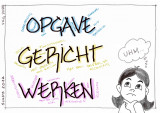
Waarom werken wij opgavegericht? Welke opgaves hebben wij te doen? deze een paar andere vragen probeer op een simpel manier te beantwoorden in een YouTube filmpje van 17 minuten.
Floating Urban Development Challenge; Co-creating imaginable, workable and attractive scenarios

Due to lack of space and climate change, the future of living might need to partly move on to water areas. In our history of conquering the water, the Dutch have a head start in some of the challenges associated with living on- and with water. Researchers and designers are therefore imagining and conceptualizing floating urban development. However, to make it a truly realistic and imaginable future scenario, there are more hurdles to overcome. To realize floating neighborhoods, we’ll need to find solutions for more than only the technical aspects, like; financing, community support, ecological aspects, affordability and political support.
Overcoming these barriers will be difficult. We’re currently focusing on urgent (housing)crises and our collective belief on urban development is mainly focused on ‘family apartments on land’. This challenge revolves around creating imaginable and workable scenarios of urban development on water.
Cooperative challenge: How can we help to mainstream energy cooperatives and ensure that structures in society make room for them and barriers are resolved?
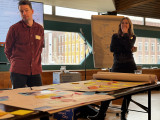
In the past decade, we have witnessed a surge of cooperatives across society. From community-led energy projects to endeavours in collective mobility and housing, citizens and companies are increasingly organizing themselves to shape their surroundings, often driven by sustainability and social goals and most of them do this in a not for profit way. Despite this rich history and the ongoing proliferation of initiatives, cooperative efforts and their benefits often remain small-scale and localized and, in most cases, accessible only to specific and select demographics.
This challenge aims to help civil society organizations in the energy domain, such as energy cooperatives, to become more mainstream. We aim to create recognition, to create an understanding of mutual interests with the key stakeholders they have to work with, and to exchange knowledge for these organizations to grow faster or repeat.
Underground Challenge: Collaborating, Sharing Data, and Co-Planning

The underground is filled with infrastructure and other assets, including electricity cables, fibre optic cables, gas pipelines, heat networks, sewers, and more. Additionally, underground spaces host natural elements crucial for maintaining a healthy urban environment, such as soil essential for urban trees. Consequently, various stakeholders regularly need access to the underground, each with their own interests, creating significant pressure on the underground. Frequent excavation leads to disruptions, extensive damage, and trees that don’t age past 60 (which is very young for trees).
Improvements can be made by enhancing collaboration among stakeholders, sharing more data, and collectively planning underground activities. Understanding the interests of all involved parties is crucial to developing an action plan aimed at enhancing the quality and management of the underground.
Circular Challenge: How Can We Stimulate Circular Business Models in the Electric Vehicle Charging Infrastructure Chain?
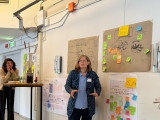
Circular initiatives often struggle to progress beyond the pilot phase, including circular charging infrastructure. Numerous barriers hinder these circular initiatives:
• Lack of data on products and how circular/sustainable they are.
• Difficulty in implementing circularity across the entire production chain.
• Regulatory obstacles.
• Current higher costs associated with circular production, leading to more expensive products.
To overcome these barriers, adjustments to regulations are necessary to better align with circular initiatives, alongside the establishment of shared ownership within the production chain.
True Price Lab is launched

The True Price Lab is a project focusing on willingness to pay the true price for food and drink.
From 26 February to mid-June 2024, the restaurant and espresso bar in the Corry Tendeloo Building of the Amsterdam University of Applied Sciences will be dedicated to the True Price Lab. For four months, students and staff will be able to choose between paying the normal or true price for a number of products. This project is an initial exploration of consumers' willingness to pay the true price, which includes hidden environmental and social-impact costs.
True price versus consumer price
The true price can be defined as the price applicable after calculating and improving the true price of a product. The true price is based on the retail price plus the sum total of external social and environmental costs. Traditional pricing disregards these external costs, which are effectively paid for by society. For example, the retail price of a cup of coffee does not include the environmental damage of pest control or the underpayment of the farmers who grow the coffee.
The full extra amount that participants pay when they voluntarily opt for the true price will go to the non-profit organisation Solidaridad. Solidaridad wants to make the world a place where everything is made and bought in solidarity with people, the environment and future generations. Visitors to the restaurant and espresso bar can learn more about what their contributions will be used for by scanning a QR code.
Revolutionise Recycling, Redefine Wealth: Seize the Opportunity with ByeBye Bed Limited and Reborn Products!

Greetings Trailblazing Visionaries,
Get ready for a seismic shift in sustainability! We're ByeBye Bed Limited, a force of innovation since 2019, experiencing a staggering 900% growth, and now we're inviting you to be part of our electrifying journey - Reborn Products.
The Powerhouse Behind ByeBye Bed Limited: Meet Paul Beckett, the maverick entrepreneur who saw a goldmine in recycling. His vision isn’t just about mattresses; it’s about transforming waste into a treasure trove of sustainable, retail-worthy products. The world is ready for this revolution, and we're leading the charge.
Dazzling Growth, Unstoppable Momentum: From a modest 6,000 sq. ft. to our current 60,000 sq. ft. facility, we've supersized our operation to revolutionise recycling on a grand scale. Brace yourself for a dedicated manufacturing facility that will catapult our capabilities into the stratosphere.
Reborn Products: Where Sustainability Meets Luxury: Our 'Reborn' products aren't just eco-friendly; they're a testament to style, comfort, and sustainability. From avant-garde mattresses to chic futon chairs and everything in between, we’re turning waste into opulence. Currently, 96% of our materials are recycled, making us the pinnacle of green innovation.
Crushing the Landfill Crisis: We're not just talking the talk; we're walking it, stomping on the UK landfill crisis that swallows almost 5,000,000 mattresses each year. We're not just recycling; we're redefining waste, turning it into a jaw-dropping spectacle of sustainability.
Financial Dynamo: Fueling the Future: Hold on tight because the next phase is a financial thunderstorm. We're not just enhancing the use of our recycled materials; we're rewriting the rules of industry, starting with furniture making. Imagine a world where our waste stream becomes the lifeblood of innovation.
Revolutionary Padding Material: Unleashing the Future: Introducing our game-changing padding material, birthed from our waste streams. It's not just 100% recyclable; it's a disruptor, challenging the status quo and reshaping the very fabric of eco-friendly living.
Invest in Tomorrow: ByeBye Bed Limited is the Future: This isn’t just a crowdfunding opportunity; it’s your ticket to invest in the future of sustainability. Join the movement, fuel the revolution, and be part of a success story that will be told for generations.
Social Impact: Building Lives, Breaking Chains: But wait, there's more! Our initiative with HMP isn’t just about recycling materials; it's about recycling lives. We're rehabilitating prisoners, re-skilling them for a triumphant return to society. And the best part? They potentially become integral members of our powerhouse workforce.
Your Invitation to Greatness: Investing in ByeBye Bed Limited and Reborn Products isn’t just about returns; it’s about being part of a seismic shift. This is your opportunity to be on the ground floor of something monumental.
Interested in More Details? Ignite the Revolution - Join Us Now: Email us for more details and become part of a future where recycling isn’t just responsible; it’s a lifestyle. Let's redefine waste, together.
Thank you for daring to dream big with ByeBye Bed Limited and Reborn Products.
Research project - Shifting circular: urban infrastructure and policy changes towards renewed territorial metabolisms
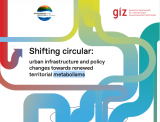
Find out this comparative analysis of critical policies and infrastructures essential for advancing the urban circular transition!
This piece of work draws upon the insights garnered from the experiences of four European cities, including Amsterdam. Reflecting on pivotal levers and obstacles pivotal in catalyzing socio-ecological transformations towards alternative urban metabolisms forms the crux of this exploration. This insightful report, commissioned by the Deutsche Gesellschaft für Internationale Zusammenarbeit (GIZ), the German agency for international cooperation, has been recently unveiled within the Circular Economy Solutions Dialogue (CESD) under the auspices of the Think20 (T20) working group focused on sustainable urbanization.
As a PhD researcher, I am now embarked on another research project on circular policies and strategies. One of my fieldwork is based in Amsterdam, spanning from January to April 2024. I am enthusiastic about establishing connections and potentially collaborating during my stay in the city!
ATELIER - Positive Energy Districts

ATELIER is an EU funded project about AmsTErdam and BiLbao cItizen drivEn smaRt cities, aiming to create and replicate Positive Energy Districts (PEDs) within eight European cities. ATELIER showcases innovative solutions that integrate buildings with smart mobility and technologies to create rather than consume energy in its two Lighthouse Cities Amsterdam (Netherlands) and Bilbao (Spain). The Fellow Cities of ATELIER, Bratislava (Slovak Republic), Budapest (Hungary), Copenhagen (Denmark), Krakow (Poland), Matosinhos (Portugal), and Riga (Latvia), will replicate and adapt the successfully implemented solutions and thus serve as testbeds for future smart cities. Overall, ATELIER will thus generate an energy surplus of 1340 MWh of primary energy and save 1,7 kt of CO2 and 23 t of NOx-emissions.
To achieve successful implementations of energy saving measures, ATELIER puts citizens at the centre of all its activities: residents (<9000), local initiatives and energy communities will be included in decision-making processes and activities and will be strongly engaged in the development of the technical solutions throughout the project. Citizens will be involved in the Innovation Ateliers to create a maximum impact for the PEDs.
30 partners from 11 countries are working in 10 work packages.
Learn more about ATELIER at its public website (http://www.smartcity-atelier.eu/) or via the ATELIER Twitter and LinkedIn channels. Sign up here (link follows) for the ATELIER newsletter. Follow the project virtually and don’t miss an opportunity to come talk to its partners at events to learn more about how ATELIER will improve the life of its citizens and the liveability in its cities!
GEMINI: Greening European Mobility through cascading innovation INItiatives
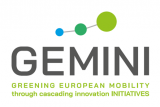
Context
At the heart of the GEMINI Project lies a commitment to fostering innovation and to accelerate the transition towards climate neutrality in mobility solutions.
Goal 11 of the UN Sustainable Development Goals advocates for access to safe, affordable, and sustainable transport systems. Nowadays, transport plays a significant role on air pollution and is one of the major sources of greenhouse gas emissions and is the only sector in the EU with increased Green House Gas (GHG) emissions compared to 1990.
The promotion of sustainable and innovative mobility solutions can help towards reducing GHG and carbon footprints, improving air quality, and achieving climate goals.
Project brief
The GEMINI Project (2023-2026 “Greening European Mobility through cascading innovation Initiatives” is a Horizon Europe funded project with 43 partners led by the Urban Electric Mobility Initiative (UEMI).
To accelerate the transition towards climate neutrality, GEMINI aims to foster widespread adoption of sustainable shared mobility solutions. To achieve this, the project will develop and test innovative business models for New Mobility Services (NMS) such as shared connected automated vehicles and shared mobility public transport through public-private partnerships. The NMS business models will be demonstrated in ten European Cities (Amsterdam, Copenhagen, Helsinki, Munich, Leuven, Ljubljana, Paris-Saclay, Porto and Turin).
Additionally, GEMINI will create digital tools and platforms that accommodate various mobility services, promoting collaboration and integration within the mobility sector. The project will actively engage stakeholders in the co-creation process, introducing Mobility as a Commons (MaaC) and incentivizing behavioural shifts and user acceptance of these new mobility options.

Furthermore, GEMINI will formulate policy recommendations to enable the scaling up and replication of successful mobility solutions. By aligning with Sustainable Urban Mobility Plans (SUMPs) and urban mobility planning frameworks, the project aims to contribute to a comprehensive policy package that guides and incentivizes future mobility innovations. The GEMINI project envisions fostering sustainable, accessible, and affordable shared mobility solutions that contribute to a safer and more environmentally friendly urban mobility landscape.
Objectives
- Develop and test sustainable business models for New Mobility Services (NMS) to increase shared mobility solutions (MaaS and MaaC) for various user groups, including enterprises, families, and tourists.
- Create digital enablers, including collaboration platforms and multimodal MaaS solutions, to integrate and facilitate a wide range of mobility services.
- Actively involve stakeholders in the co-creation of new mobility options and integrate Social Innovation practices to incentivize behavioural changes and user acceptance.
- Formulate policy recommendations to support the scaling up and replicability of successful mobility solutions, contributing to the development and implementation of SUMPs and urban mobility planning frameworks.
Cenex NL key contributions
The team plays a vital role in developing policy recommendations and technology roadmaps to accelerate the deployment of innovative mobility services. Through collaboration with local authorities in twinning cities, these roadmaps will align with the fast-track deployment of shared mobility trends in the short and medium term. Additionally, Cenex NL will contribute to the development of the Handbook consolidating the project’s learnings and offering practical guidance to cities and citizens across Europe.
This project has received funding from the European Union’s Horizon Europe research and innovation programme under grant agreement No 101103801.
SESA project – Smart Energy Solutions for Africa to accelerate the green transition and energy access

Context
Africa is the fasted growing continent on the planet, measured both in GDP as in population, which historically is accompanied with a growth in energy consumption. With an eye on the Paris Agreement and COP26 it is clear the energy should be Low or even Zero Emission. However, it is important this does not stifle the economic growth allowing millions to climb out of poverty. With this in mind the EU funded the SESA project that aims at mitigating climate change while improving access to sustainable energy under affordable, reliable conditions.
Project brief
SESA is a four-year (2021-2025) EU H2020 funded R&D project designed to combine innovative energy access solutions for a range of applications in both urbanised and rural contexts in Africa. These solutions will include decentralised renewables (solar photovoltaics), innovative energy storage systems (including second life batteries), waste-to-energy systems (biomass to biogas), smart microgrids, (micro) mobility solutions, climate-proofing, resilience and adaptation, and rural internet access.
SESA focusses on testing, validating and replicating those energy innovations through co-developed demonstration actions in 9 sites across the continent (1 Living Lab for testing, 4 for validation and 4 for replication).
The collaborative project is the result of a strong partnership between leading European and African universities, research centres, industry actors, local governments, knowledge and implementation organizations and networks.
Objectives
The main goal of SESA is to support a diversity of affordable solutions that help provide access to reliable, affordable, and sustainable energy services for all, creating new business opportunities and developing concepts that can directly contribute to a low-carbon development. It further provides policy makers with recommendations aiming at creating a favourable regulatory environment to ensure long-term impacts of the solutions developed. In addition, a key deliverable for the project is the SESA Toolbox, which will contain materials relating to the following main building blocks:
- Impact assessment
- Capacity building
- Business plans and models
- Innovations tested in demonstration actions
- Design, operations and management for different solutions
- Financing & funding options
- Policy support
Cenex NL’s key contributions
Cenex NL leads the work package responsible for the development of the key repository of the project, the so called “SESA Toolbox”, and the evaluation of the project results available in the toolbox. Our team will be involved in three tasks:
- Build a scalable and harmonised toolbox for advanced implementation, management and operation strategies of efficient sustainable energy solutions.
- Develop an evaluation framework based on the Life Cycle Assessment (LCA) methodology to quantify and compare the environmental impacts of the proposed solutions.
- Assess the impact of the solutions developed in at least five the demonstration and validation projects using the framework developed in the previous task.
This project has received funding from the European Union’s Horizon 2020 research and innovation progamme under grant agreement No 101037141
Professionals in romanian local public administration. Smart city managers
City Managers Association in Romania (AAPRO) was founded in 2010, as a follow-up of a pilot project called “Public Administrator – a success factor for an efficient management at local level” carry out by the Central Unit for the Public Administration Reform (a structure within the Romanian Ministry of Administration and Interior Affairs).
AAPRO is commited to form a national, relevant, elite and professional Body of City Managers, who must have a clear image on the background of this career and become responsible for their professional conduct and self-improvement.
The initiative to introduce the City manager position at each local level in Romania targets an higher lever of professionalism at counties, municipalities, cities and communes staff.
The romanian equivalent of the city manager can be hired upon the Mayor’s proposal or the one of the local council (wich must give the final aproval anyway), after a transparent selection process. His main responsibilities are to coordinate some of the public administration affairs and services (on an agreed agenda) and to do other specific tasks delegated by the Mayor / President of County Council, all of these concluded in a management contract, based on clear management objectives and performance criteria.
The City Manager is one common thing among the efficient and successful local governments
all over the world. Adopting him in the romanian administration was a step from public adminsitration to public management, focusing on delivery good qaulity services for the citizens. The Public Administrator, as we call it here, is not another birocrat, but a strategist, a visonary, balancing day-to-day (organizational) problem solving with planning and shaping the future, acording to the adopted local strategy and the community aspirations.
At the local level, the elected body and the technical staff, coordinated by the Mayor or the President of County Council and the Public Administrator, must first find aut and understand what people want, need and hope, then come up with a strategy, an action plan, seek for solutions, means and resources, involve the local actors such as bussines community and civil society, and communicate at any moment what has been done so far, and what is is comming.
In this picture, the City manager has a leading role, he is an communicator, technology facilitator, and can be, if the Mayor delegates him, even budget chief authorizing officer. Currently, in Romania activate more than 700 Public Administrators (the number varies from month to monyh), as follows :
- Out of 41 counties, 34 ocupied positions and 7 vacancies
- Out of 103 municipies, 56 ocupied positions and 37 vacancies
- Out of 216 cities, 60 ocupied positions and 65 vacancies
- Out of 2850 communes, 550 ocupied positions and 350 vacancies
Those above figures makes 459 vacancies in total, with the observation that, in many cases, we are talking about small comunes with scarce Romanian City Managers Association (AAPRO) conducted a survey among its members that identified the needs for training, building local capacities on climate protection, urban regeneration, structural changes and energy policies, concept of smart city and creatively intelligent communities.
Establishing appropriate training structures for the now and future City Managers is essential for supporting the development of the cities and climate strategies (it aims to encourage cities and municipalities to take concrete actions for climate protection in Romania), urban regeneration and structural changes, concept of smart city and creatively intelligent communities.
This project focuses on the competences that the city managers must have in order to achieve a multiplication effect through their contribution. The nationwide implementation of a systematic local energy management using the City Managers can thus make an important step to tapp existing saving potentials in different regions and to establish a sustainable portfolio management.
We hope that, with your support, that the outcomes of this important project, can be forwarded on an extended scale to the local institutions (schools, hospitals, etc) and communities, as good practices, improving the energy efficiency status and reducing the energy poverty, urban regeneration and structural changes, concept of smart city and creatively intelligent communities.
The pilot group will be composed of 50 to 80 city managers upon their self enrollment and applying few clear selection parameters : level of municipality, experience, english language, etc. The target group will be afterward authorized to further train other city managers and employees of the local municipalities. This core team is expected to disseminate the information and to act as an experts group in our Association.
As Romania has (at this moment) a deficit of at least 250 city managers, the learning and workshops center will be powerful tool, a public management academy and a testing facility for the ones applying for this position.
The Supportclub

Our idea: The Supportclub, let’s look after someone, as a team
The Supportclub makes volunteering for another person fun and easy to do. Our app carefully designs teams around a person in need, based on skills and fields of interests. Our network partners invites people that need a little help or company, informal care to make a profile as a supportee. Our campaign recruits people that want to help somebody, the supporters. They also make a profile.
The Supportclub app matches supporters based on their interests and skills. The app creates (temporary) teams around a supportee, e.g. Annie → Support team Annie. The Supportclub facilitates the teams to work together for Annie providing handy features like notification, a calendar, chat and monthly meet-up for the team.
The Supportclub proposition for supporters:
- look after a person that needs some help (18+)
- in a carefully designed team
- for a fixed period of time
- with social team activities
- facilitated by an app
Join the Supportclub!
The Support club proposition for supportees:
- Do you need some help or company?
- Register yourself at The Support Club and get a team. Three to five people that are willing to look after you. They do it together and make new friends while doing it.
- You let us know what your needs are and we do the rest.
Join the Supportclub!
Stay up to date
Get notified about new updates, opportunities or events that match your interests.

